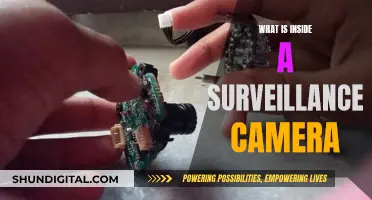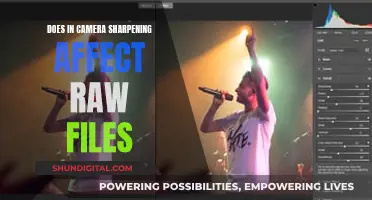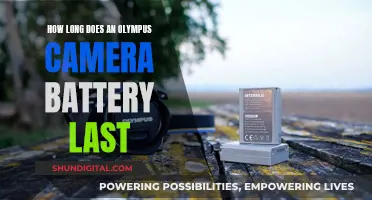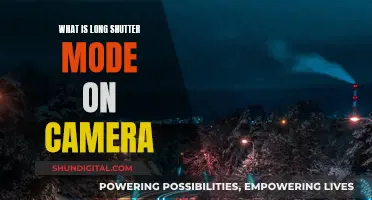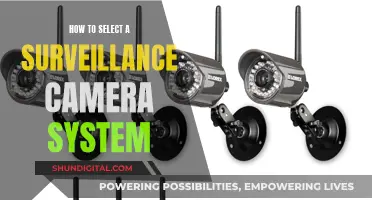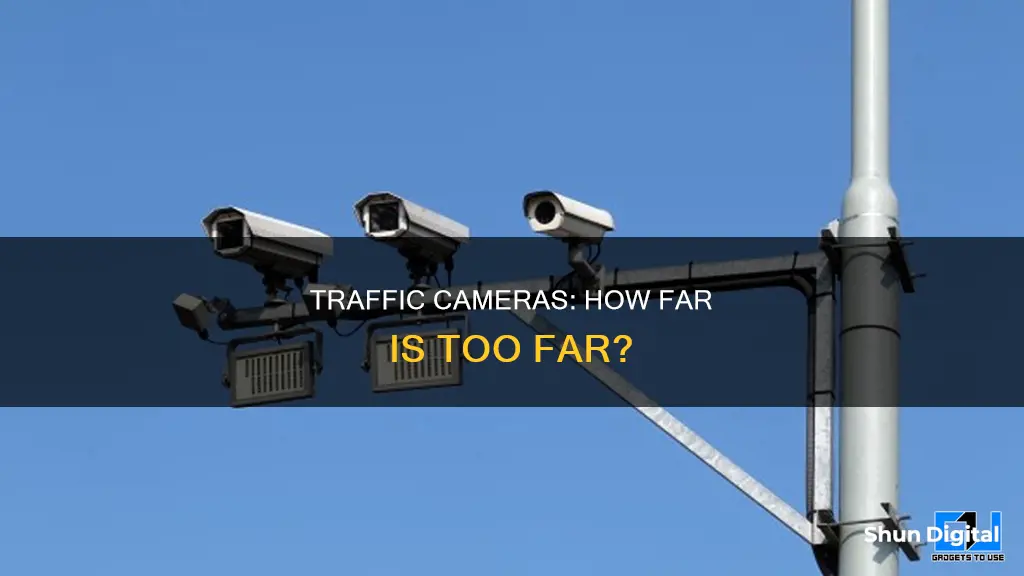
Traffic cameras are an increasingly common feature on roads and intersections across the United States. They are used to monitor traffic patterns and enforce road safety, with the data showing that they decrease accidents and save lives. There are several types of traffic cameras, including red light cameras, speed cameras, and traffic sensor cameras, each with its own unique purpose and functionality. One important question that arises is how far these cameras can see. The visibility range of traffic cameras varies, but it can extend up to several hundred feet, allowing them to capture images and videos of vehicles breaking traffic laws.
| Characteristics | Values |
|---|---|
| Visibility range | Up to several hundred feet |
| Purpose | Monitoring traffic patterns, reducing accidents, enforcing speed limits, etc. |
| Placement | Traffic lights, street lights, highways, roads, intersections, poles, vans, etc. |
| Type | Dummy, fixed, mobile, automatic enforcement, non-enforcement, etc. |
| Storage capacity | Stored for a few days to several months |
What You'll Learn

Traffic cameras can see up to several hundred feet
Traffic cameras are an increasingly common sight on roads and intersections across the United States. These cameras are typically placed on poles or street lights several meters high, and are positioned to capture vehicles driving through the intersection from multiple angles. While some cameras are fixed, others are mobile and can be relocated or moved around to different spots.
The range of traffic cameras varies, but they can generally see up to several hundred feet. This enables them to capture footage of vehicles that move through intersections or speed by them. The cameras are usually triggered by movement and can capture short video clips or photographs of vehicles that violate traffic laws, such as running red lights or speeding. The footage or images captured by these cameras can be used as evidence in court or for issuing traffic citations.
In addition to enforcement purposes, traffic cameras also have a monitoring role. They can be used to monitor traffic patterns, detect incidents, and manage traffic flow. This information can be valuable for traffic management and improving road safety.
It is important to note that not all traffic cameras actively record footage. Some only take photographs, while others may be dummy cameras that are not hooked up to anything. The presence of a camera does not always guarantee that it will capture the desired footage, as its angle or position may be limited. Additionally, the footage captured by these cameras is typically not stored long-term and may be deleted after a few days.
The Emergence of 4K Cameras: A Historical Overview
You may want to see also

They are placed on poles or traffic lights
Traffic cameras are typically placed on poles or traffic lights, offering a comprehensive view of intersections and roads. These strategic placements enable several functions, including monitoring traffic flow, detecting incidents, and enforcing speed limits.
Cameras mounted on poles are often used for red light enforcement. They are positioned several meters high and angled inward to capture vehicles driving through the intersection from different angles. Red light cameras are usually bulky with a large camera box and two external flashes, often mounted separately on poles. They are often placed on all four corners of an intersection to capture images from multiple directions.
On the other hand, cameras placed on traffic lights are typically used for traffic monitoring and surveillance. These cameras are generally small, cylindrical, or dome-shaped, enclosed in weatherproof housing. They are used to measure traffic flow and determine traffic light timing rather than for enforcement purposes.
The placement of these cameras ensures a clear view of the area they are monitoring. For example, cameras on traffic lights can effectively monitor and manage traffic flow, while cameras mounted on poles are well-positioned to capture vehicles running red lights or monitor traffic patterns.
By utilising these strategic placements, traffic cameras play a crucial role in road safety and traffic management, contributing to a reduction in accidents and improved traffic flow.
Computer Camera Taping: Privacy or Paranoia?
You may want to see also

They are used to monitor traffic flow and detect incidents
Traffic cameras are used to monitor traffic flow and detect incidents. They are placed at road intersections, on poles several meters high, and are positioned to capture vehicles driving through the intersection from multiple angles. These cameras are triggered by movement and typically capture around 12 seconds of footage when a vehicle moves through the intersection after the light turns red. The footage is used to identify vehicles that violate traffic laws, with the license plate number being vital information for issuing traffic citations.
In addition to red light cameras, there are also speeding cameras, which are usually found on less populated back roads and residential areas. These cameras capture footage of vehicles exceeding the speed limit and are either fixed, mounted on elevated poles, or mobile, located on a tripod or inside a van.
Traffic sensor cameras are another type of camera used for monitoring traffic. These cameras are typically installed on top of traffic signals or mounted high on light poles above roadways. They are used to measure traffic flow and determine traffic light timing, and are not tied to any enforcement system.
Overall, the use of traffic cameras helps to enhance traffic management and safety, providing valuable evidence in the event of accidents or incidents.
The Ultimate Dual Camera Car DVR Guide
You may want to see also

They can be used to enforce speed limits
Traffic cameras are an increasingly common feature on roads and highways across the United States. While they are the subject of some controversy, they are an important tool for enforcing speed limits and other traffic laws, and have been shown to improve road safety and save lives.
Speed cameras are a type of traffic camera that automatically detects and issues violations for speeding. They are usually placed on less populated back roads and in residential areas where speeding is a common problem. There are two types of speed cameras: fixed and mobile. Fixed speed cameras are mounted on elevated poles at the side of the road and are easy to spot due to their bulky weatherproof enclosures and external flashes. Mobile speed cameras, on the other hand, are more challenging to notice as they are not permanently mounted and can be located on a tripod or inside a van. They also use a special type of radar that is difficult for radar detectors to detect.
When a vehicle exceeds the speed limit, speed cameras typically capture around 12 seconds of video footage, along with images of the license plate. This evidence is then used by law enforcement to issue a citation to the vehicle owner. While some argue that traffic cameras remove the human touch from the ticketing process, they are an effective tool for enforcing speed limits and improving road safety.
In addition to speed cameras, red light cameras are also used to enforce traffic laws. These cameras are placed at busy intersections and are designed to detect when a vehicle enters the intersection on a red light. They capture multiple images of the car during the violation, which can later be used as evidence in court. Red light cameras are usually mounted on tall poles near the intersection and may have a separate flash mounted on a pole.
By capturing violations and issuing citations, traffic cameras play a crucial role in deterring speeding and reducing the number of accidents on our roads. They provide an efficient and reliable method of enforcing speed limits, even in areas where police presence may be limited. While some may view them as an intrusion, the ultimate goal of these cameras is to enhance road safety and protect drivers, pedestrians, and other road users.
Disabling Night Owl Cameras: Display Mode Tips
You may want to see also

They can be used to issue tickets
Traffic cameras are an increasingly common sight on roads across the United States, and they serve a variety of purposes, including monitoring traffic patterns, enforcing traffic laws, and improving road safety. One of their key functions is to issue tickets for traffic violations.
Red light cameras are a type of automated ticket-issuing system that is typically placed at busy intersections. These cameras detect when a vehicle enters an intersection on a red light and capture multiple images of the car during the violation. The recorded images can be used as evidence to prosecute the driver in court, and the registered owner of the vehicle will receive a ticket in the mail. Red light cameras are usually mounted near busy intersections and can be identified by their bulkier size and the presence of external flashes mounted on poles.
Speed cameras are similar to red light cameras in that they automatically detect and issue violations, but they specifically target speeding violations. These cameras are often placed on less populated back roads and residential areas where speeding is a concern. There are two types of speed cameras: fixed and mobile. Fixed speed cameras are mounted on elevated poles at the side of the road and are easily spotted due to their bulky weatherproof enclosures and external flashes. Mobile speed cameras, on the other hand, are more challenging to notice as they are not permanently mounted and can be located on tripods or inside vans.
In addition to red light and speed cameras, there are also school bus cameras designed to catch drivers who illegally pass stopped school buses. These cameras capture short footage of the offending vehicle, which can be used to issue citations.
It's important to note that while traffic cameras can be used to issue tickets, the footage is not always stored long-term. Some databases may only retain the footage for a few days before it is deleted. Therefore, if you need to use traffic camera footage as evidence following a traffic incident, it's crucial to act quickly and consult a lawyer who can assist in obtaining the footage.
Mastering Camera Raw Filter: Multiple Layers, One Easy Step
You may want to see also
Frequently asked questions
The visibility range of traffic cameras varies but can extend up to several hundred feet.
Traffic cameras are usually small, cylindrical or dome-shaped cameras enclosed in a weatherproof housing. They are mounted on poles or traffic lights, and are distinct from red light cameras, which are bulkier and often have external flashes.
Traffic cameras have a variety of functions, including monitoring traffic flow, detecting incidents, enforcing speed limits, and capturing images or video of vehicles breaking traffic laws.


